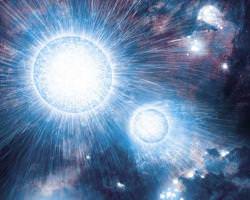Many of the stars in the Universe are located in binary or multiple star system, where several stars orbit a common centre of gravity. But astronomers have discovered an extreme binary system, where two of the largest possible stars orbit one another.
The discovery was made using NASA’s Far Ultraviolet Spectroscopic Explorer (FUSE) satellite, as well as ground-based observatories. FUSE turned up a system called LS54-425 in the Large Magellanic Cloud, a satellite galaxy of the Milky Way. This system contains two stars: one with 37 times the mass of the Sun, and the other is 62 solar masses.
Although they’re extremely massive, these two type-O stars only orbit one another at 1/6th the distance between the Earth and the Sun, completing an orbit within 2.25 days. Both stars are generating massive solar winds, which collide, giving off X-rays and ultraviolet radiation. And this is how FUSE was able to spot them.
The more massive star is shedding material about 400 times as fast as our Sun, and the smaller star gives off about 40 times as much material. As they age and grow, the two stars will transfer a tremendous amount of material to each other, and eventually they will merge, creating a single star of 100 times the mass of the Sun.
And then, within just a few million years, this super star will detonate as a very energetic supernova.
Original Source: NASA News Release

